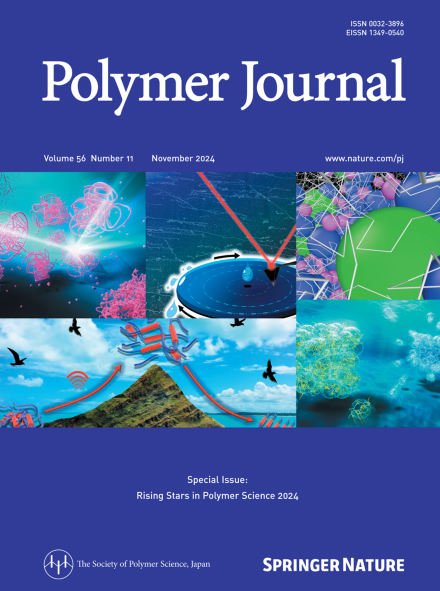动态共价三维纳米颗粒交联剂模板聚合生成的水凝胶中交联点的快速高效重组
IF 2.3
4区 化学
Q3 POLYMER SCIENCE
引用次数: 0
摘要
动态共价键(DCBs)可以作为交联点来诱导水凝胶中的自愈和热塑性性能,因为分子之间的键合和解离可以由外部刺激控制。然而,一旦DCB解离,分子在凝胶内扩散,延迟了DCB的重组。在本研究中,通过模板聚合制备了苯基硼酸包覆的纳米颗粒,以控制分子的迁移率和DCB交联点的密度。有趣的是,根据硼酯键的形成/解离,水凝胶的损失模量随温度的变化而变化,而不是存储模量。此外,与传统的水凝胶相比,由于高密度的三维DCB交联点限制了分子在凝胶内的扩散,因此制备的水凝胶的物理化学性质随温度的变化变化非常快。结果表明,随着温度的变化,制备的水凝胶具有快速自愈和热塑性性能。以三(羟甲基)甲基丙烯酰胺(THMAAm)为包被剂,通过模板聚合法制备了新型水凝胶TempGel(NP)。这个过程形成动态的硼酯交联,形成高密度和均匀的三维网络。创新的结构表现出可逆的热响应性,使键在温度变化时能够快速解离和重组。纳米颗粒周围的致密填料最大限度地减少了分子扩散,确保了卓越的自我修复,高热滞后和可调的粘弹性特性。这种创新的设计为智能材料、生物医学设备和反应性水凝胶的先进应用提供了一个强大的平台。本文章由计算机程序翻译,如有差异,请以英文原文为准。

Rapid and highly efficient recombination of crosslinking points in hydrogels generated via the template polymerization of dynamic covalent three-dimensional nanoparticle crosslinkers
Dynamic covalent bonds (DCBs) can be used as crosslinking points to induce self-healing and thermoplastic properties in hydrogels because the bonding and dissociation between molecules can be controlled by external stimuli. However, once DCBs dissociate, molecules diffuse inside the gel, delaying DCB reformation. In this study, a hydrogel was prepared via template polymerization using phenylboronic acid-coated nanoparticles to control the mobility of the molecules and the density of the DCB crosslinking points. Interestingly, the loss modulus, but not the storage modulus, of the hydrogel changed with temperature according to the formation/dissociation of boronic ester bonds. Furthermore, compared with conventional hydrogels, the hydrogels prepared here exhibited very rapid changes in physicochemical properties in response to changes in temperature because the high density of three-dimensional DCB crosslinking points limits the diffusion of molecules inside the gel. As a result, the prepared hydrogel showed rapid self-healing and thermoplastic properties as the temperature changed. A novel hydrogel (TempGel(NP)) was synthesized through template polymerization of phenylboronic-acid-coated nanoparticles with tris(hydroxymethyl)methyl acrylamide (THMAAm). This process forms dynamic boronic ester crosslinks, creating a highly dense and uniform three-dimensional network. The innovative structure exhibits reversible thermal responsiveness, enabling rapid bond dissociation and reformation upon temperature changes. The dense packing around nanoparticles minimizes molecular diffusion, ensuring superior self-healing, high thermal hysteresis, and tunable viscoelastic properties. This innovative design provides a robust platform for advanced applications in smart materials, biomedical devices and responsive hydrogels.
求助全文
通过发布文献求助,成功后即可免费获取论文全文。
去求助
来源期刊

Polymer Journal
化学-高分子科学
CiteScore
5.60
自引率
7.10%
发文量
131
审稿时长
2.5 months
期刊介绍:
Polymer Journal promotes research from all aspects of polymer science from anywhere in the world and aims to provide an integrated platform for scientific communication that assists the advancement of polymer science and related fields. The journal publishes Original Articles, Notes, Short Communications and Reviews.
Subject areas and topics of particular interest within the journal''s scope include, but are not limited to, those listed below:
Polymer synthesis and reactions
Polymer structures
Physical properties of polymers
Polymer surface and interfaces
Functional polymers
Supramolecular polymers
Self-assembled materials
Biopolymers and bio-related polymer materials
Polymer engineering.
 求助内容:
求助内容: 应助结果提醒方式:
应助结果提醒方式:


